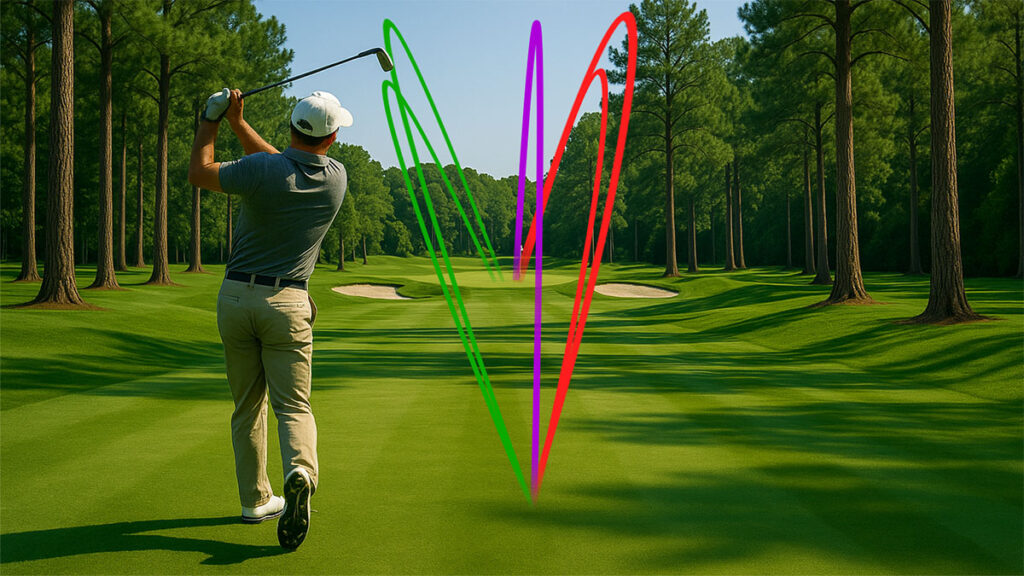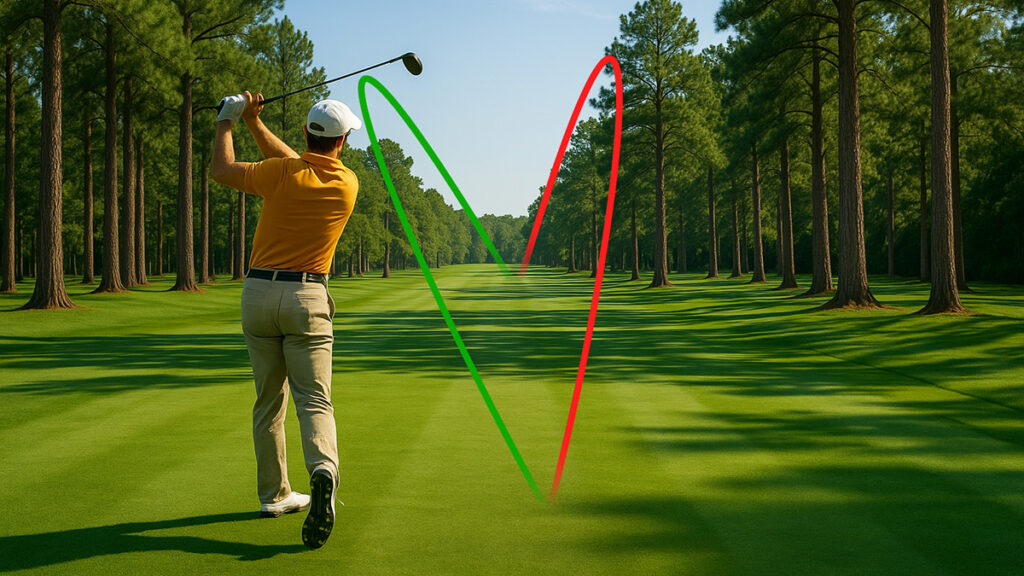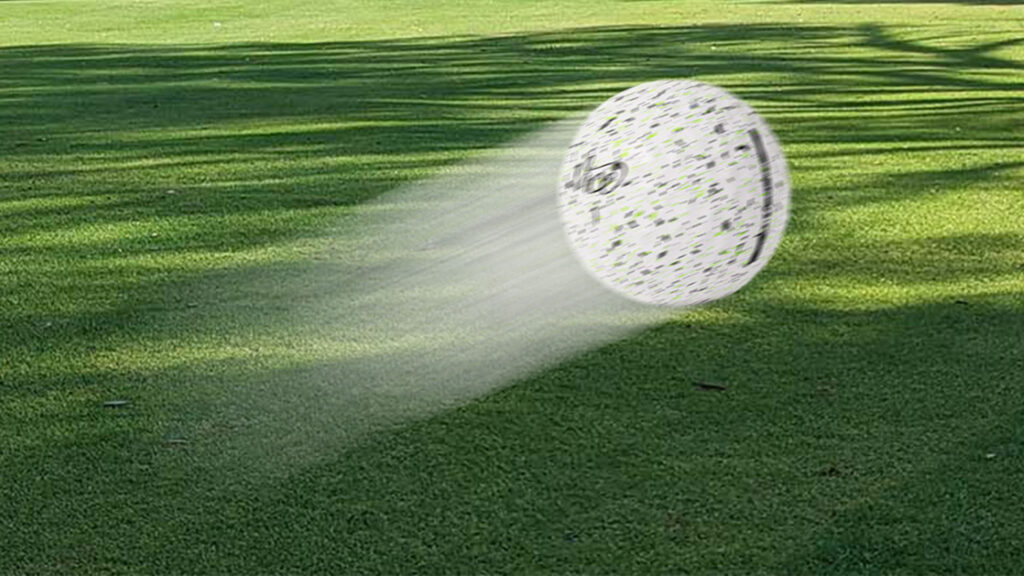How to Shape Golf Shots

Learning how to shape golf shots can elevate your game to an elite level by giving you the control needed to handle various course challenges. In this guide, we’ll explore actionable techniques to adjust your swing and setup for different shot shapes. You’ll gain the skills to draw your driver around a tricky dogleg or fade an iron shot into the green to avoid a nasty bunker. Controlling your shots with precision allows you to navigate obstacles, adapt to course conditions, and manage difficult lies confidently.
Be aware – shaping shots is not for the faint hearted, it is one of the most difficult things to do in golf, and it’s even more difficult to do it well!
Snapshot: Shot Shaping
- Mastering shot shaping involves altering your swing and setup to achieve a desired ball flight. Which can noticeably improve your performance on the course.
- Key elements for effective shot shaping include swing path, club face angle, and ball position. All of which greatly influence the trajectory and curvature of your shots.
- Practicing different shot shapes through drills and on-course practice is essential for building the confidence and skill needed to navigate various challenges in golf.
Mastering the Art: How to Shape Golf Shots for Every Situation
Shot shaping can elevate your game to new heights. And, you don’t need to be a professional golfer to start shaping your shots.
It involves making fine adjustments to your swing or setup to achieve a desired ball flight. This might mean starting the ball out to the right and it tracks back to the left during flight. This could be used on a dogleg or to avoid a hazard such as a bunker. Shaping shots also involves control of the flight height, keeping it low to avoid high winds or overhanging branches, or hitting it high to avoid obstacles.
The ability to shape shots provides you with more control and a significant advantage on the course. It is particularly useful for undulating courses, I used to have a bad slice off the tee and dreaded fairways which sloped to the right because I’d know they’d end up in the right rough.
To shape shots effectively, it’s often better to adjust your setup rather than change your entire swing path. And, these adjustments are just small tweaks, the biggest mistake people make when trying to shape their shot is altering their swing too much. Practicing different shot shapes on the range and committing to the intended shot are key for success. With dedication and practice, you can master the art of shaping golf shots for every situation you find yourself in on the course.
There are nine primary types of golf shot categorized by their trajectory and direction. These shot shapes include:
- High draw
- Mid draw
- Low draw
- High Straight
- Normal
- Punch
- High Fade
- Mid fade
- Low fade
This guide will equip you with the knowledge and confidence to shape shots like a pro.
Key Elements of Shot Shaping
Effective shot shaping is influenced by several key factors, including swing path, club face angle, and ball position. Each of these elements plays a crucial role in determining the trajectory and curvature of your golf shots. Manipulating these elements of your swing technique and setup can help you achieve the desired shot shape with consistency and accuracy.
Let’s delve deeper into each of these 3 key elements.
Swing Path
The golf swing path is a critical factor in shaping golf shots. A golf club moving along an inside-out path generally promotes a draw, while an outside-in path is likely to produce a slice. An inside-out swing path helps generate right-to-left spin, promoting draws, while an out to in path tends to create left-to-right spin, often resulting in slices.
Align your body to the right and ensure your swing path comes from the inside to hit a draw. Conversely, an outside-in path creates a fade. Adjusting your swing path helps you effectively shape your shots to meet the golf course’s demands.
Club Face Angle
The club head face angle at the moment of impact is the main determinant of the ball’s starting direction. If a right-handed player has a closed club face at impact, the ball usually starts left of the target. A square club face promotes straight shots, while an open or closed face can lead to slices or hooks, respectively.
Adjusting the club face at address can significantly influence the trajectory and curve of the shot you intend to play. The angle of the club face at impact is crucial for controlling the ball’s trajectory and curvature. Mastering this element helps you achieve the desired shot shape with greater precision.
Ball Position
Altering the ball’s position in your stance can significantly affect both the trajectory and curvature of your shots. Adjusting the ball’s position within your stance can alter both the shot’s trajectory and curvature, allowing for greater control over the shot shape. For example, placing the ball slightly forward in your stance can help achieve a higher trajectory, while moving it back can produce a lower flight, in accordance with ball flight laws.
By understanding how to adjust ball position, you can influence the trajectory and spin of your shots effectively. This simple yet effective technique can be a game-changer in your shot-shaping arsenal with a golf ball, promoting a natural ball flight.
Techniques for Hitting Different Shot Shapes
There are several techniques for hitting different shot shapes, each serving specific purposes on the course. From hitting a draw or fade to executing high and low shots, understanding these techniques can help you navigate various course challenges. A draw is characterized by starting outside the target line and curving back toward it, while a fade starts inside and curves away. Learning to hit draws can enhance your game significantly.
Next, we’ll explore specific methods for hitting draws, fades, high shots, and low shots. Each technique involves particular adjustments to your swing, setup, and club selection, allowing you to shape shots with precision and confidence.
Hitting a Draw

To produce a draw, place the ball closer to your left foot and close the right hand over the left on the grip. The orientation of the club face at impact is a determining factor for the ball’s initial direction and curve. Many right-handed players tend to hook or draw the ball when hitting with short irons.
Ensure your alignment supports a draw by aiming slightly right of the target. This setup, combined with an inside-out swing path, can help you achieve a consistent draw shot.
Hitting a Fade

For a fade, aim the clubface slightly left of the target while aligning your body to the left. This setup encourages an outside-in swing path, which creates left-to-right spin on the ball.
Practicing this technique helps you reliably hit fades when needed.
High Shots
Hitting high shots requires a flexible wrist position at impact to maximize loft. Adjusting your swing and club selection to increase loft can help achieve the desired high trajectory. You want to finish your shot with a high and long follow through. It’s important to avoid ‘scooping’ the ball which might give you some extra high but will reduce your length.
This technique can improve your ability to hit high shots consistently.
Low Shots
To achieve low shots, use a lower lofted club and focus on a compact follow-through. A compact follow-through reduces the loft and keeps the ball trajectory low. It might feel a bit more like a short sharp ‘punch’ of the ball rather than a full swing. It’s important to keep your backswing the same as usual so you don’t vary it up too much.
Low shots are essential when navigating under obstacles or it’s very windy. Mastering the low shot adds another valuable shot shape to your repertoire.
Advanced Shot Shaping Strategies
Combining multiple shot shapes involves assessing both trajectory and the type of curve needed for the situation. Adapting shot selection to the specific conditions of the course can greatly enhance performance. Whether you need a high draw or a low fade, understanding how to combine these elements is crucial.
Next, we’ll explore advanced strategies for combining trajectory and curve and making effective recovery shots. These techniques will help you navigate complex course conditions with confidence.
Combining Trajectory and Curve
When needing to play multiple types of golf shots, consider the situation and potential trouble if the shot is misplayed. A key factor in developing a shot shaping strategy is knowing how to hit the opposite shot.
Mastering the ability to combine different trajectories and curves lets you tackle any course condition with ease.
Recovery Shots
For recovery situations, the choice of shot shape is influenced by the direction of obstacles relative to where your ball lays. I learnt to play a low draw because of recovery shots from out of the rough. When I got rid of my slice off the tee I’d sometimes overcorrect my swing path and end up hooking it into the left rough. From there, often the best shot was a low draw to get it back out on the fairway and bend left towards the green.
Recovery shots are essential for navigating difficult lies or obstacles, even the pros play recovery shots regularly.
Mental Preparation for Shot Shaping
Visualization can enhance confidence and muscle readiness by mentally rehearsing the desired shot. Successful athletes often visualize their performance to improve focus and reduce anxiety before executing shots. Mental imagery allows golfers to mentally engage the same muscles they would use in a physical shot.
Visualization helps golfers maintain a calm mindset, especially under tournament pressure. Practicing unusual shots helps golfers understand their mechanics and improve overall performance. Incorporating these mental preparation techniques enhances your shot-shaping abilities.
Practicing Shot Shaping
Practicing shot shapes on the range before using them in play is crucial for success. Understanding the basics of each shot before attempting on the course can help you build the confidence needed to execute them effectively. One effective drill for improving shot shaping skills is the 9-ball drill.
Practicing recovery shots on the range builds confidence and keeps the mind engaged. Dedicating time to practice helps you master the art of shaping shots and enhances overall performance on the course.
Range Drills
Hit a few low, punch 6-irons followed by high wedges, then fairway woods with a draw. Practicing different shot shapes on the range improves your overall game and adaptability on the course.
These drills can help you develop a more versatile game.
On-Course Practice
Drop a few balls that you’ve worked on at the range and test yourself with various shots. Incorporating shot-shaping practice into regular play helps maintain and improve skills developed on the range.
Friendly competitions can make practice more enjoyable and encourage creative shot shaping on the course.
Summary – How to Shape Golf Shots
Mastering the art of shaping golf shots is a multifaceted journey that involves understanding the basics, practicing diligently, and mentally preparing for each shot. By focusing on the key elements of swing path, club face angle, and ball position, you can control the trajectory and curvature of your shots with precision. Techniques for hitting different shot shapes, such as draws, fades, high shots, and low shots, enable you to navigate various course challenges effectively.
Advanced strategies, including combining trajectories and curves and executing recovery shots, further enhance your ability to manage complex course conditions. Mental preparation and consistent practice, both on the range and on the course, are crucial for honing these skills. By embracing these techniques and strategies, you’ll be well-equipped to shape shots like a pro, improving your overall performance and enjoyment of the game.
Frequently Asked Questions
What is shot shaping in golf?
Shot shaping is all about adjusting your swing or setup to control how the ball flies, letting you tackle different course challenges more effectively. It’s a handy skill to have when you want to maneuver around obstacles!
How does the swing path affect shot shape?
The swing path is crucial in shaping your shots; an inside-out swing generally creates a draw, whereas an outside-in swing often results in a fade or slice. Adjust your path to achieve the desired shot shape!
What role does the club face angle play in shot shaping?
The club face angle at impact is crucial because it dictates where the ball starts and influences its trajectory and curve. Adjusting this angle can help you shape your shots more effectively.
How can adjusting ball position help with shot shaping?
Adjusting the ball position in your stance can significantly influence your shot’s trajectory and curvature, giving you better control for shot shaping. By moving it forward or back, you can create higher or lower flights and shape your shots more effectively.
Why is practicing shot shaping on the range important?
Practicing shot shaping on the range is essential because it builds your confidence and helps you become familiar with the necessary adjustments, leading to better performance on the course. So get out there and start shaping those shots!


